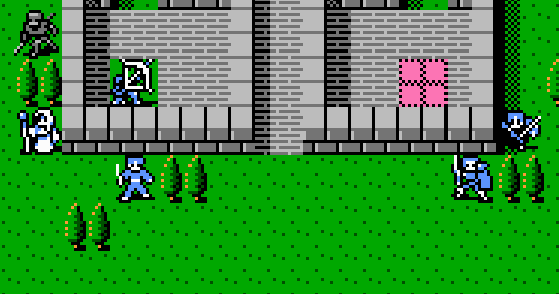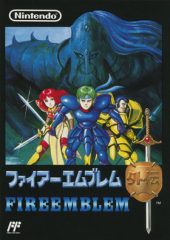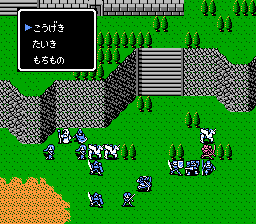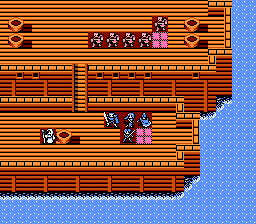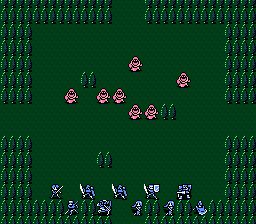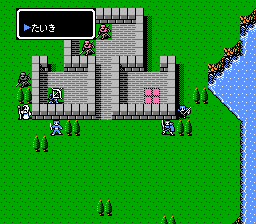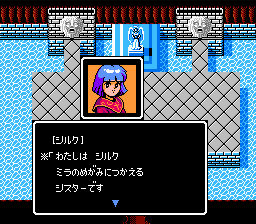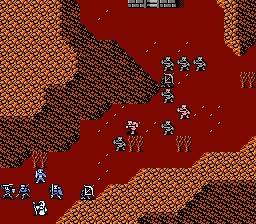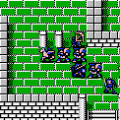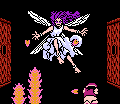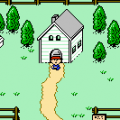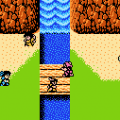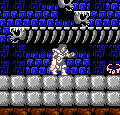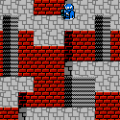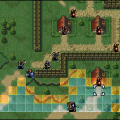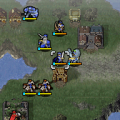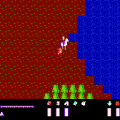- Fire Emblem (Introduction)
- Fire Emblem: Ankoku Ryu to Hikari no Tsurugi
- Fire Emblem Gaiden
- Fire Emblem: Monshou no Nazo
- Fire Emblem: Seisen no Keifu
- Fire Emblem: Thracia 776
- Fire Emblem: Fuuin no Tsurugi
- Fire Emblem (GBA)
- Fire Emblem: The Sacred Stones
- Fire Emblem: Path of Radiance
- Fire Emblem: Radiant Dawn
- Fire Emblem: Shadow Dragon
- Fire Emblem: Shin Monshou no Nazo
- Fire Emblem Awakening
- Fire Emblem: Fates
- Fire Emblem Echoes: Shadows of Valentia
- Fire Emblem (Misc)
Fire Emblem Gaiden was released two years after the original. While most of the graphics have been recycled (outside of some improved combat animations) and the clunky interface is practically identical, this sequel takes many other drastic departures from its predecessor.
Fire Emblem Gaiden takes place on the faraway continent of Valentia, where the gentle god Mila and the demonic god Duma fought thousands of years ago. After the battle, Valentia was split into two parts. Zofia, the Kingdom of Scripts, was established in the south, and the Rigel, Kingdom of Knights, was established in the north. Emperor Rudolf of Rigel amasses an army in an attempt to unite Valentia under his rule. With the help of Dohza (also known as Desaix), a holy knight that betrayed Zofia, the Kingdom of Script is now collapsing.
There isn’t much crossover with the plot of the original Fire Emblem, though a few characters make appearances, like the trio of Pegasus Knight sisters – Catria, Palla and Est – and Camus, previously an enemy, who has lost his memory and refers to himself here as Zeke.
Characters
Alm
A young boy from the village of Ram. Trained by the knight Mycen, he gathers and leads an army to free Valentia from the tyranny of Rudolf. He promotes to Hero later on and gains the ability to use bows as well as swords. Appears with blue hair in-game, but all of his other depictions show him with green hair. While initially treated as a lowborn peasant, he has a secret past, indicated by the mark on his hand.
Celica
A close childhood friend of Alm, who was carried away to another village at a young age. Under the watch of Mila’s Great Sage Nouma, she masters magic and the sword. She doesn’t know her country of origin, as she spent most of her childhood with Alm in Ram. Her quest starts out on an island far south of Valentia. She is joined together with Alm with a similar mark on her hand, indicating a lineage that she does not initially expect.
The game starts with Alm and three young villagers from the town of Ram in his army. You have the option of changing these villagers into one of five classes – mages, cavaliers, mercenaries, archers or soldiers. From then on, they’ll proceed down a linear class change path. It may seem simplistic, but it’s a lot more customizable than most Fire Emblem titles. The game takes you through two quests, one lead by Alm and the other by Celica. Eventually you can control them on the same overworld map and alternate between them as will, though beyond an extremely brief encounter in the middle of the game, their paths won’t cross until the very end. Therefore, all of their party members are separate (though you can trade items between each other through the use of peddlers). Their stories focus on slightly different elements even though they’re both on the same side – Alm’s path focuses on directly fighting the generals of the Rigelian army, while Celica’s concentrates on the pirates that roam the land and the evil forces that are manipulating the war from behind the scenes. It’s quite a rowsing moment when the two parties finally join together for the penultimate battle.
There are a huge number of differences between Gaiden and the original game, most of which were discarded for subsequent entries. So, as with Castlevania II, Zelda II, and Super Mario Bros. 2, it suffers from that “second installment weirdness” of other NES sequels. For starters, you can walk around towns and talk to people, plus there are dungeons to explore. There’s an overworld map which lets you walk around the continent of Valentia, with enemy units that need to be dealt with before you can proceed. Sometimes new enemy units spawn on the field as well. Beacuse of this, rather than having a fixed number of number of battles, you’ll get into many, many more fights in this game than in most of the others. Conversely, this is one of the few early Fire Emblem games where you can actually revisit older maps for experience. For the most part, level grinding is practically a necessity, given some of the immensely strong foes you’ll face.
Others bits of strange mechanics are abound as well. Archers can attack at point blank, whereas normally they have a blind spot in the spaces immediately surrounding them. Magic spells now drain the spellcaster’s HP, making them even more vulnerable if you keep them too close to the fray, but conversely, the healers also have spells that can steal enemy HP for their own. There’s no need for any items to promote your characters, you just reach a certain level and then visit a shrine of Mila. There are also limited-use fountains which can be used to level up certain stats, and a few can even revive fallen characters. characters always have a default weapon. So rather than having individual pieces of equipment, each character can only hold a single item. These can be offensive or defensive items to boost stats, or can be a consumable item to restore health on the battlefield. Weapons never wear down either, so you never need to worry about them breaking. There are no stores, or even any form of currency.
There’s also a greater emphasis on randomness in this game. Terrain plays a huge part in determining whether an attack hits or misses, and you’ll find more critical attacks occurring here than most other Fire Emblem games. Units are balanced differently too. Archers are extremely powerful here, as they can attack outside of the range of all of the other units with the right equipment/class, but they’ll also miss more often, so they’re also unreliable. Unfortunately some of the maps make for some irritating battles, especially the ones with squares where you can only move a single space a turn, or even worse, sap your health. There are also enemies that can summon several smaller units into battle, and certain enemies, witches, that can teleport around at will. If you’re really unlucky, they’ll teleport next to a weak unit and kill them immediately. And rather than focusing primarily on human (and dragon) combat, there’s a larger number of monsters and undead creatures to fight this time around. It’s quite a difficult game, as to be expected, but there’s also a hidden Easy mode that doubles obtained experience and makes some other tweaks, like allowing you to trade items between parties at will. Finally, all of the games in the Fire Emblem series feature a red haired girl with a ponytail named Anna. Except for this one, anyway.
Because of all of this, Fire Emblem Gaiden was regarded as the bastard child of the series. However, the years have vindicated it a bit, as the Game Boy Advance game Fire Emblem: The Sacred Stones brought back the map screen and dual protagonists, plus it was given the remake treatment with the 2017 3DS game Fire Emblem Echoes: Shadows of Valentia. Sega’s Shining Force series for the Genesis also borrows many of its elements (like walking around towns) from this entry.
